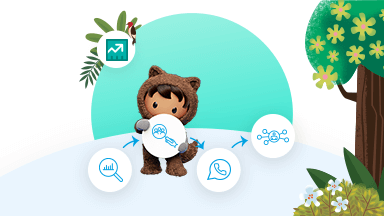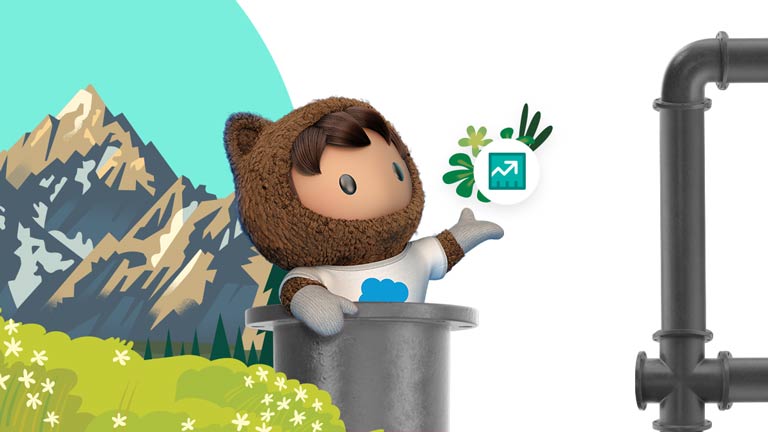How to Build A Sales Process That Lands Deals Every Time
Learn how to successfully land a sale, from prospecting to closing the deal.
Business growth expert Tiffani Bova said it best: “How you sell matters. What your process is matters. But how your customers feel when they engage with you matters more.”
The sales process is not merely a series of steps that result in a sale. It’s a way to connect with prospects and customers. Over time, you understand their pain points and can provide solutions that make their jobs — and lives — easier. This results in customer loyalty, consistent sales, and, over time, business growth.
Sounds complicated? Don’t worry, we break it down for you in this guide.
What we’ll cover:
What is the sales process?

What are the main sales process steps?
1. Build product knowledge
Until recently, sales teams and product experts were often separate. If a sales rep struggled to answer a product-specific question during a sales call, they referred the prospect to an internal product manager.
Today, clients increasingly expect sales reps to know their products inside and out. The advantage is clear: Not only does this streamline communication and accelerate the sales cycle, it gives reps the knowledge and confidence they need to handle objections.
The best way to learn your products is by reviewing product demos, press releases, and documentation. Then, use them. Ask developers or product managers questions about functionality, use cases, and potential pitfalls. Write your own notes highlighting standout features and the problems they solve for customers.
2. Research your ideal prospect

If you don’t have access to a buyer persona, spend time researching your target market. Here are key questions to guide your research:
- What buyer data do I already have that can help me outline the ideal prospect?
- What unique needs does my product or service address, and who has these needs?
- What are the characteristics of prospects targeted by my competitors?
- Where do my ideal prospects live, and how do they engage with businesses like mine?
There are many tools you can use to gather this information, but it’s easiest to start by collecting insights from your company’s CRM. If it has built-in analytics, like Sales Cloud, you can see where past sales came from and the basic demographic information or business details of buyers. You can also collect information on buying habits, including the average purchase frequency of buyers, which products are most popular, and average sale amounts.
Then, take the time to add institutional knowledge to any CRM data you collect. Talk to tenured sales reps and managers about customers with whom they’ve worked and collect information about their behaviors, communication patterns, needs, and pain points.
To round out your research, use a competitor research analysis tool to learn how your competition is using marketing, pricing, service, and sales tactics to attract customers. What strategies bring in the most business for competitors and how can you make use of them to find prospects?
3. Begin prospecting and lead generation
Prospecting is the process of finding individuals or businesses that are good candidates for a sale.
Start by asking fellow reps or industry connections for referrals, then peruse online portals and communities for viable prospects. Search for product or industry keywords on broad-scope engagement platforms like LinkedIn, then move to trusted, niche sites that prospects commonly use for product research.
If you need additional help, use Google keywords related to your product or business and look for relevant sites where potential prospects are engaging via comments or forums. This allows you to collect more information about their needs and pain points. When you identify a prospect you’d like to pursue, find them on LinkedIn or ZoomInfo and collect all available contact details.
You can supplement these efforts with inbound lead generation campaigns. While traditional prospecting is outbound, requiring outreach to those who might be interested in your product, lead generation campaigns pull interested contacts into your pipeline via display ads, paid search ads, and social media ads. Work with your advertising or marketing teams to create these campaigns, and be sure to target audiences that match your buyer persona.
Lastly, make the most of your CRM to streamline the prospecting process. If you leverage a tool like Sales Cloud’s Einstein Relationship Insights, you can use automated workflows and digital assistants to conduct research across the web and score prospects to see which are the most likely to convert.

4. Qualify prospects
Not all prospects are created equal. Before you can make a pitch, you need to verify that your product is a good match for the prospects you’ve identified. This requires a qualification call.
The qualification call collects basic information about need, budget, timeline, and authority that allows you to identify prospects most likely to buy. During the call, you should focus on the following key questions:
- What does the prospect need, and does this need align with your product?
- Do they plan to make a product purchase soon? If so, when?
- How much do they have to spend on your product?
- Who has the authority to make the purchase?
Cynthia Barnes, founder of the National Association of Women Sales Professionals (NAWSP), recommends framing this as a checklist that can guide conversation rather than a list of very direct questions. “Don’t make it feel like an interrogation,” she said. “Treat your prospect like you would your best friend.”
5. Analyze a customer’s needs
Once you’ve narrowed your list of viable prospects, take a deep dive into the needs of those who remain.
Set up another call with each prospect to further understand what they need and how you might meet that need (known as a discovery call). Keep in mind that 95% of buyers make purchase decisions based on emotion, so understanding a prospect’s emotional levers is key.
Below are a couple of probing questions that can guide this discussion:
- What pain points or problems do you have right now?
- How have these problems affected your day-to-day work or life?
- What’s preventing you from finding lasting solutions?
- If you implemented solutions that didn’t work, why didn’t they work?
- What would an ideal solution look like?
Remember: This is not an inquisition. Keep the conversation free-flowing and natural. Once you have answers to the questions above, you can easily identify products that will solve prospect problems. If a prospect doesn’t identify a problem that can be solved with your product, remove them from your list.
6. Lead a sales call
It’s finally time to schedule a sales call and present your pitch. This is an opportunity to present your product as a solution to the prospect’s problems.
Make sure to tailor your pitch to the prospect and stick to a discussion of solutions, not product features. This customized approach makes the prospect feel valued.
Also, write out likely objections shortly before the call. Draft responses that will overcome these objections and have them with you when you give your presentation. Be careful not to launch into a full-throated defense when you hear objections. Take the time to ask for additional details and context so you can understand the root of the problem.

Barnes suggests combining your preprepared responses with the “Feel, Felt, Found” formula: “I understand how you feel. Others have felt the same way about [our product]. However, they have found that [our product] is worth the money/time/energy because [reason].”
Lastly, suggest a timeline for next steps at the end of the presentation. This should include any follow-up calls and a proposed deadline for the sale to close.

PRO TIP
7. Follow up and close the deal
Immediately after the sales call, follow up with the prospect, summarizing your conversation and reiterating next steps. If additional information was requested, send this with your follow-up message.
The prospect may respond with additional questions about your product. Answer these right away and urge them to make a purchase decision by the date specified during the sales call. You can make this easy by sending a PDF contract with an electronic signature (e-sign) field.
8. Nurture the relationship and upsell
If all goes well, your prospect is now a customer. Congratulations! But the sales process isn’t over yet. Satisfied customers provide a huge opportunity for cross-selling and upselling. As Alex Turnbull, CEO and founder of Groove, noted, “Upselling isn’t just a sales tactic; it’s a customer happiness tactic that can help you build deeper relationships with customers by delivering more value.”
Barnes’ Formula of 3s makes this easy:

Check in to make sure the client is satisfied.

Check in to see if the client has any questions or product issues.

Check in to confirm satisfaction with the product and service, then ask for a referral.
“Don’t forget the human side of sales. People buy from those they know, like, and trust.”
“Don’t forget the human side of sales. People buy from those they know, like, and trust.”
What are common sales process mistakes?
1. Poor preparation
Research is key to successful sales. When done correctly, it allows you to speak confidently about what you’re selling and what problems it solves. When done poorly — or not at all — prospects lose confidence in your product and business.
Take the time to understand both what you’re selling and your target audience before you ever make a sales call. Not only will you avoid embarrassing fumbles, but you’ll be able to address unique problems and value propositions in your prospect communications.
2. No needs analysis (discovery) call
Many reps think that a qualifying call is sufficient background to pick out the best prospects on their list. In most cases, however, this call is very high level and doesn’t adequately paint the picture of a prospect’s needs.
Barnes calls this out as a common issue with new reps and recommends a separate call for discovery. “Take the time to hear about [your prospects’] pain points in-depth. Only when you fully understand these pain points can you offer a solution.”
3. Making a sales pitch before qualifying leads
Many eager salespeople are so focused on quotas and commissions that they forget the qualifying and discovery calls and launch straight into the sales pitch. The result is often a dead end — the unvetted prospect has little interest, insufficient budget, or is not empowered to make buying decisions.
Take the time to learn about your prospect’s alignment with your products before a sales call and you’ll dramatically increase your chances of closing a deal.
4. Highlighting product features, not value
It’s common for reps to lead a sales call touting product features. The problem is, prospects aren’t looking for features. They’re looking for solutions and value.
As executive sales coach Jay Abraham advises, “Sell the benefit, not the company or the product. People buy results, not features.”
5. Being unempathetic
Laser-focused on closing deals, reps can come across as pushy. Nobody wants to make a buying decision under pressure.
Don’t think of your prospect as a potential client. Think of them as a friend. Listen to their problems with empathy. It builds trust and loyalty, which make a purchase decision easier.
Make the sales process a cinch with Sales Cloud
6. Talking too much
Constant talking is often cited as the number-one mistake salespeople make. It alienates prospects and scuttles once-promising deals. In fact, many studies have demonstrated the negative impact of talking more than listening during sales calls. The takeaway is the same: Reps who consistently close deals listen more than they talk.
The golden ratio is hard to pin down, but many experts recommend a 60/40 split in favor of listening. This gives reps enough time to share value-based insights while making sure the prospect is heard.
7. Being unprepared for objections
There are countless potential objections to a sale: cost, bad timing, insufficient need, lack of product functionality, and so on. While these will vary depending on the prospect, they’re often easy to anticipate. Unfortunately, many reps struggle to close sales due to common objections they don’t know how to overcome.
The best solution is to map out all likely prospect objections before you make your pitch. Then, use Barnes’ “3 Fs Formula” along with your product and prospect research to prepare empathetic and impactful responses.
8. Making sales calls too long
In the era of virtual selling, sales leader and consultant Larry Long Jr. notes reps struggle to keep calls short enough to retain prospects’ attention. The result, he says, is poor engagement and waning product interest.
Fortunately, the solution is easy: Keep your calls (in-person or virtual) to 30 minutes max. This forces you to avoid tangents and focus on sales-critical information.
9. Waiting too long to follow up
“The longer you wait to follow up with a prospect after a sales call,” cautions Barnes, “the colder the sale becomes.” Lazy or distracted reps sometimes leave days between the sales call and their follow-up email. By that point, the interest generated in the product has faded, making the close far more difficult.
Avoid this pitfall by sending follow-up messages immediately after your sales call. And keep following up — “until they tell you to stop,” Barnes advises.
“Whatever your methodology, make sure you align it with the sales process in your system of record (CRM). If you don’t, it will never be adopted.”
“Whatever your methodology, make sure you align it with the sales process in your system of record (CRM). If you don’t, it will never be adopted.”
What’s the difference between a sales process and a sales methodology?
As a final note, it’s worth understanding the difference between the sales process and sales methodology. They are frequently used interchangeably, but are two distinct concepts. Think of the sales process as the “what” of the sales equation — the steps necessary to close a deal and nurture a new client or prospect relationship. A sales methodology is the “how” — how a rep executes each step in the process and engages a prospect or customer. When you put the right “what” and the “how” together, you increase your chances of successfully closing a sale.
We’ll get more into the “how” of sales in later chapters of this series, but for now, it’s important to know which methodologies are commonly used by sales teams.
Popular sales methodologies include:

Challenger Selling

Trigger or signal-based selling

Value-based selling

360-degree selling
More Resources

State of Sales

See How Sales Cloud Makes Selling Easy










